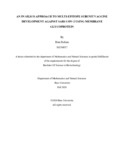| dc.contributor.advisor | Siddique, Romana | |
| dc.contributor.author | Rafsan, Rian | |
| dc.date.accessioned | 2021-05-29T08:57:22Z | |
| dc.date.available | 2021-05-29T08:57:22Z | |
| dc.date.copyright | 2020 | |
| dc.date.issued | 2020 | |
| dc.identifier.other | ID: 16336017 | |
| dc.identifier.uri | http://dspace.bracu.ac.bd/xmlui/handle/10361/14440 | |
| dc.description | This thesis is submitted in partial fulfilment of the requirements for the degree of Bachelor of Science in Biotechnology 2020. | en_US |
| dc.description | Catalogued from PDF version of thesis. | |
| dc.description | Includes bibliographical references (pages 82-87). | |
| dc.description.abstract | SARS Cov -2, short for Severe Acute Respiratory Syndrome Coronavirus-2 is a + sense zoonotic
retrovirus of the Coronaviridae family and is genetically a mutant version of the SARS Cov and
is the causal organism of the Covid-19 disease. First reported on the 31st of December, 2019 in
the Wuhan, Hubei province of China the disease was soon declared a pandemic by the WHO on
the 30th of January 2020. The virus itself is claimed to have originated from snakes, bats and
pangolins as potential carriers in the ‘wet markets’ of Wuhan where live wild animals are sold
for consumption under poor hygienic conditions. As such, the environment is ideal for viral
growth and transmission particularly via faeces, blood, semen and other fluids of biological
origin from the carriers.Patients of this disease are majorly symptomized by mild to moderate
fever, runny nose, dried cough and tiredness along with respiratory arrest in extremely severe
cases, particularly elderlies.
Although medicinal drugs such as hydroxy-Chloroquine and Remdesivir are claimed to be
potential therapeutic candidates against this virus , no credible vaccine has yet been successfully
developed that can efficiently combat this disease. Here, we tried to develop a multi-epitope
sub-unit vaccine against SARS Cov-2 using the membrane glycoprotein (M) as the primary
antigen in our vaccine construct. Our choice of antigen was carried out based on two basic
features ;(i)Antigenicity of the protein.(ii)Functionality of the protein.To measure the
antigenicity of our proteins we used the Vaxijen 2.0 server.At a minimal threshold set to 0.5 ,
antigenicity of the potential protein candidates preliminarily selected were measured . A total of
12 proteins’ primary structures were primarily retrieved in FASTA format from NCBI website .
Among the candidates were 10 non-structural proteins (nsp2-11) and 2 structural proteins -
namely the Spike glycoprotein (S) & membrane glycoprotein (M) . The membrane glycoprotein
(M) was selected for further analysis.CTL epitopes were then identified using NetCTL 1.2
server.CTL epitopes were analysed for MHC I allele specificity and HTL epitopes corresponding
to MHC II alleles respectively using the respective IEDB servers . Unique epitopes were selected
and epitopes that were mutually homologous or partially homologous were excluded.Linear B
cell epitopes were identified specific to our primary antigen using Bepipred Linear Epitope
Prediction 2.0 algorithm at a minimal threshold of 0.5.All the selected epitopes were then added
4
to the primary antigen using proper linkers to enhance stability of our vaccine . Biochemical
analysis was done using the PROTPARAM tool. Next we built a PDB structure of our final
vaccine using phyre2 server via homology modelling that was docked with the TLR8 receptor
of toll-like receptor family.We further validated the credibility of our vaccine’s efficacy by
carrying out an in silico simulation analysis using C-immsim server . We believe that the vaccine
we developed will be a potential candidate to effectively combat SARS Cov-2 . We also believe
that further in vitro analysis is required to get a clear understanding of this vaccine and its further
development. | en_US |
| dc.description.statementofresponsibility | Rian Rafsan | |
| dc.format.extent | 87 pages | |
| dc.language.iso | en_US | en_US |
| dc.publisher | Brac University | en_US |
| dc.rights | Brac University theses are protected by copyright. They may be viewed from this source for any purpose, but reproduction or distribution in any format is prohibited without written permission. | |
| dc.subject | Vaccine development | en_US |
| dc.subject | SARS COV-2 | en_US |
| dc.subject | Membrane Glycoprotein | en_US |
| dc.title | An in Silico approach to multi-epitope subunit vaccine development against SARS COV-2 using Membrane Glycoprotein | en_US |
| dc.type | Thesis | en_US |
| dc.contributor.department | Department of Mathematics and Natural Sciences, Brac University | |
| dc.description.degree | B. Biotechnology | |

